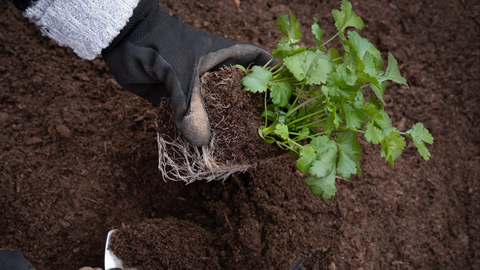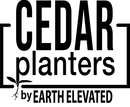Tips For Transplanting Your Seeds Outdoors
By Victoria Fuller
If you live in the United States your Spring has just as much chance of looking like a tropical paradise as it has of looking like the Arctic Tundra, and this can wreak havoc on your garden plans!
Perhaps you want to cultivate a delicious vegetable garden but you are worried that your seedlings will freeze before they have a chance to even break ground, or perhaps you would like to grow flowers to create your own beautiful bouquets and arrangements but the unpredictable weather is making it impossible to know when to start. Never fear! Transplanting is here to help you make the most of your gardening season!

WHAT IS TRANSPLANTING?
To break it down: transplanting is the removal of a plant or tree from one location and resetting it into the ground (or garden bed/planter box) of another location! When we at Cedar Planters discuss transplanting we are generally referring to the planting of your seeds or seedlings in your raised garden bed after either purchasing them at the garden center already on their growing journey or from seeds that you have lovingly nurtured yourself indoors while awaiting for retreat of the frosts.

WHAT CAN I TRANSPLANT?
Certain plants will transplant better than others but that’s not to say that you should rule any out completely! Generally any crop that “grows for its roots” such as Carrots, Turnips, and Beets don’t tend to transplant well as you are having to disrupt their entire root system during the transplanting process and once you have disrupted their large taproot it can be difficult for the plant to readjust to a new location.
Other vegetables however have a much higher success rate once transplanted to their “forever garden bed”, especially hardy varieties are Lettuce, Cabbage, Broccoli, and Spinach!

If you are looking to transplant your flower seedlings we would recommend doing so in the early morning before the sun is too high in the sky (this will reduce “transplant shock” which can cause your plants to wilt). The key to helping avoid any complications when transplanting your flowers is to water them well as soon as your transplant them!

WHAT WILL I NEED?
As far as gardening goes, transplanting plants requires one of the smallest toolkits of all! You will need a Hori Hori knife or trowel to safely and effectively dig up your plant from its original growing area, some potting soil to help bury your plant in its new home, and some water to ensure that your plant immediately starts settling in! These are the only three things that you will need for a successful transplant!
If you are transplanting large plants like shrubs or small trees then we would recommend using a wheelbarrow and some sturdy gardening gloves just to ease the process along!
IS TIMING IMPORTANT?
Choose a time a day with the least harsh sunlight when choosing your transplanting time! Early morning and late afternoon are both optimal times for giving your plants the opportunity to settle into their new soily home without immediately exposing them to the harshness of the midday sun!

WHERE SHALL I TRANSPLANT?
We would recommend transplanting your seeds, seedlings, and plants into a Cedar Planters Western Red Cedar planter box or raised garden bed! These high quality garden beds are the perfect solution as they have a built-in drainage system to assist the roots in retaining just the right amount of moisture and thus helping to avoid transplant shock!
Our garden beds also have an optimal 12" planting depth giving your plants the perfect amount of room to spread their roots while providing you the perfect amount of gardening space to succeed!
Another excellent idea to reduce potential transplant shock is to utilize a greenhouse cover! Cedar Planters have greenhouse covers that are custom-designed to fit our planter boxes and raised beds and they are fantastic at reducing the impacts of extreme cold spells and shelter from wind and pests!
WHAT ARE THE GENERAL STEPS FOR TRANSPLANTING?
Now that you know the ins and outs of transplanting we can advise the following 5-steps for transplanting:
- Remove the seedling from its original pot or vessel
- Examine the plants' roots and gently loosen them if they are covered in soil.
- Plant your plant in a pre-dug hole, preferably at soil-level
- Pat soil around the plant with your hands (to help ease your plants into their new home you could also add some organic matter such as mulch or organic fertilizer to your garden soil to help your plants grow!)
- Water well to encourage the plant to acclimate and grow its roots into the new soil

CONCLUSION
All in all we hope that this blog post has inspired you to try transplanting your own seeds! If you live in a chillier state it can be frustrating to think that you perhaps only have a 3 or 4 month gardening season, but if you take 6-8 weeks in the Springtime to cultivate your seeds indoors there is no reason that as soon as the pesky frosts have left for the season that you can’t transplant those seedlings outdoors and have a head start!
Have you had any personal success with transplant in your raised garden bed? Are there certain vegetables or flowers that you think transplant extremely well or perhaps not well at all? If so please let us know in the comments section below as we love to hear from you!











Hi:
I have 2 of your cedar planters. I have started seeds too early for zone 7b, for pole beans. I’m a new gardener and so now I’m wondering whether to start with direct plant seeds if may plants die before April 15 when I can transplant to 60 degree soil, or whether to pinch back some leaves of the seedling plants (keeping enough leaves for it to absorb sun) until April 15, assemble my cedar planter with soil and greenhouse cover, and go ahead and plant my seedling plants in the greenhouse cover, and take the cover off for trellising after the temps are warmer. Any advice is appreciated….Thank you!
———
Cedar Planters replied:
Great to hear you’re prepping for spring! Starting seeds early is a common learning experience, and luckily, beans are forgiving. Since pole beans like warm soil (60°F+), you can direct sow when the weather allows. If saving your seedlings, pinch back leaves to slow growth while keeping them healthy. Your greenhouse cover idea is smart! If the soil warms above 60°F during the day, you can transplant earlier with the cover on—just watch night temps. Once it’s consistently warm, remove it for trellising. You’re on the right track—gardening is all about learning! Let me know if you have questions. Happy growing! 🌱
Leave a comment